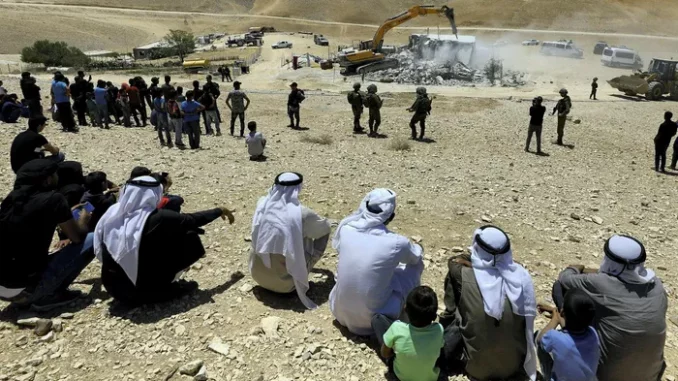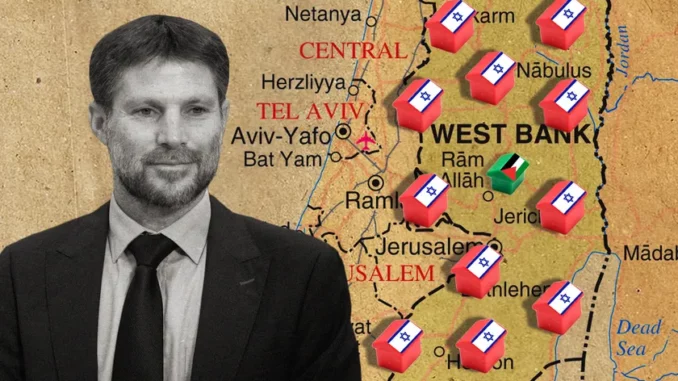Israel’s far-right government ministers are no longer hiding their dreams of wildly proliferating the settler population.
Israeli Finance Minister Bezalel Smotrich who has a plan for massive settlement expansion.Credit: Photos: Hadas Parush Artwork by Anastasia Shub
There are three recent developments related to Israel’s West Bank settlements that at first glance seem unconnected, but are actually all deeply intertwined. They are part of the bigger picture of settler power reestablishing itself with unprecedented muscle in this Israel’s government.
First, it was revealed last week that Bezalel Smotrich the far-right Finance Minister, who is also de-facto Minister of Settlements requested government ministries to prepare plans and budgets to double the number of settlers living in the West Bank. This would mean seeing their numbers soar from half a million to one million people.
Then it was reported that a Palestinian community of approximately 200 residents from the hamlet of Ein Samia, located east of Ramallah, fled the land they’d been living on for some 40 years, driven out by (ALLEDGED) persistent and devastating violence from settlers.
- Far-right Israeli minister lays groundwork for doubling West Bank settler population
- Why Homesh is not just another illegal Israeli outpost in the West Bank
- Israel’s absent finance minister serves the settlements
On Monday came the news that Israel’s government is now officially permitting its citizens to establish a permanent presence in the Homesh outpost in the northern West Bank, breaking past commitments to the U.S. not to do so.
Once a low-key mostly secular settlement that was evacuated by the Israeli government in the summer of 2005, it has since become rallying cry for the settler movement.<
It arguably goes hand in glove with Smotrich’s massive expansion plan, which itself is not new, but is newly transparent.
Israel’s Finance Minister Bezalel Smotrich enters the Old City of Jerusalem at a parade marking “Jerusalem Day” last week.Credit: HAZEM BADER – AFP
Those familiar with the plans stored away in the files of the Ministry of Housing and the Civil Administration, which oversees the West Bank, already know that there are existing plans to establish tens of thousands of housing units in the settlements of Givat Eitam, E1, Atarot, Gva’ot, Nahliel, Emanuel, Givat Zeev and more.
The infrastructure for this settlement expansion, which the government has already started implementing, is currently being laid down thanks to billions of shekels being poured into the construction of a network of highways to accommodate the million settlers Smotrich envisions.
What’s new in Smotrich’s plan is that his intentions are explicitly and openly placed on the table, with no fear of any opposing forces posing a genuine threat to it.
For years since 1967, a cloud of ambiguity surrounded the settlement project. Despite the fact that the settlements have had the most significant impact on Israel’s security, political, economic, and social situation and have determined its destiny, governments refrained from presenting their vision and plans on the matter to the public. It was important for them to maintain the public’s perception that we are the “good guys” and that the prolonged bloody conflict with the Palestinians was not due to our occupation and settlement policy but rather to the Palestinian refusal to compromise.
I remember, when I started working at the Settlement Watch Project for Peace Now 18 years ago, that if we wanted to know what was planned for a particular settlement, we had to go to the local council and request to see the plan. The existence of the planning meetings would be discovered, if at all, only weeks after they took place, hidden in small ads in newspapers.
To find out if the land on which a settlement was built was privately owned by Palestinians, we needed leaks from sources within the Civil Administration.
Today, much of this information is readily available with the click of a button online largely due to our persistent efforts and those of other organizations to expose the information. But it is not only the information that is available, but the intentions of the government that are much clearer and more explicit.

An Israeli soldier and a Jewish settler and her child at the West Bank outpost of Homesh, Monday, after Israel’s government repealed a 2005 act that had dismantled it.Credit: Ohad Zwigenberg /AP
It seems the government now feels no immediate threat to the fate of the settlements, so they have nothing left to hide.
The opposition parties in Israel avoid dealing with the occupation. In the United States, until fairly recently, there was a president openly supportive of settlements. The current administration as well as other countries and international organizations only lip service condemning the settlements but do not exact any price from Israel for its policy.
Smotrich and his colleagues feel invulnerable. So, reveling in this new level of power and possibility they seek to remove the few remaining legal obstacles in their path to implementing their apartheid vision through the judicial revolution the government is conveniently leading.
But perhaps this very success of the settlers is also an opportunity.<
Since their plans and intentions are clearly on the table, today there can be no more debate about the intentions of the Israeli government. If we continue as usual, avoiding the subject or paying a lip service against it, the plans will come to fruition and if our passivity continues, sooner or later the settlers will reach the million.
But it is not only about the million settlers and it’s not about the numbers in the first place. For many good people in Israel and abroad, even 500,000 settlers were enough to despair of the possibility to undo it and of a two states reality.
This despair led them to search for a new vision, of one state, and by doing so, they are effectively taking the wind out of the sails of the struggle against settlements. The settlement project goes beyond the mere numbers of Israeli settlers in the West Bank; it’s a tragic story that entails the dispossession of Palestinians. It is not a new vision that we need but action, strategies of struggle in order to stop this injustice.
The focus on numbers and the resulting despair often overlooks the impact of Palestinians including the Ein Samia community, forced to flee due to settler violence.
It overlooks the Palestinian owners of the lands on which the Homesh settlement was established who cannot return to their land due to the settlers’ presence and their violent attacks against them. It also neglects communities like Masafer Yatta and Khan al-Ahmar which are being displaced from their lands.

Palestinians watch as Israeli machinery demolishes a Palestinian house in Masafer Yatta near Hebron, the West Bank last July.Credit: MUSSA ISSA QAWASMA / REUTERS
Additionally, it fails to address the tens of thousands of Palestinians whose homes are under imminent threat of demolition and the hundreds of thousands of Palestinian landowners who have had their lands seized for the benefit of settlements.
The numbers debate also usually ignores the millions of Palestinians enduring life under a harsh security regime to ensure the secure existence of these settlements. Dispossession is intrinsically linked to the settlement enterprise. It is an ongoing reality that is independent of the future question of whether there will be one or two states.
Now that we, the Israeli public and the international community, know what Smotrich and this government is planning – and already working to make happen – we must take action to stop it.
We should develop strategies for a long and persistent struggle: one that harnesses all potential forces opposing this policy of dispossession. A struggle that includes the silent majority in Israel now rallying to protect Israeli democracy for Jews, although they currently appear largely indifferent about the lack of democracy for Palestinians. A struggle that includes Israeli Palestinian citizens who remain excluded from the mainstream public debate in Israel.
It should be a struggle that includes mobilizing the clear and outraged voice of the world Jewish community. We also need the international community to take genuine action tied to real consequences for Israel if it does not change course.
Hagit Ofran works at the Settlement Watch project of Peace Now





It is obvious that Hagit Ofran would be ecstatic if the UN reinstated its slanderous “Zionism is racism” declaration.
I for one am grateful that Israpundit published Ofran’s screed as a warning to all patriotic Israeli citizens that they must remain vigilant lest anti-Zionists — such as Ofran, Peace Now, J Street, Biden democrats, intransigent Palestinian Arabs, radical left-wing members of the Israeli opposition, and malicious EU NGO’s — hoodwink the Jewish people into giving away their birthright.
I am as aware as anyone of what you all say against Haaretz and Peace Now.. Nevertheless, I believe that by posting the odd article by Haaretz, my readers can distinguish facts from smears. Am I wrong here?
Among the garbage, this article highlights Smotrich’s plan to colonize J&S has not been covered by anyone in English so far as I know.. You will recall that he included a large sum of money in his budget to finance the improvement of the roads there to accommodate the 500,000 Israelis living there and the 500,000 slated to move there.
This has also missed the point that this building plan could become a massive exercise in giving hostages to not just fortune but the expansion of normalisation, security, and the reputation that soft power as well as hard power needs.
Besides what sort of economy are these hill tops to be part of? What will be their water security ? Some things have not changed since King David.
Haaretz has come to represent the “aretz” of Palestinians, not Jews.
Let them move their “news”paper to Ramallah.
It will be very welcome.
Contrary to the writer’s sad lack of facts, most land in Judea and Samaria is not owned by the Palestinians. It was treated as Turkish land when occupied by the Turks, British when occupied by the British and Jordanian when occupied by the Hashemites. Only now when in possession of its indigenous owners, the Jews, is it not allowed to be treated as Jewish…and of course, when our liberal Israeli Jews say it is not ours, our enemies use this against us.
Lots of “plans” have been made to expand the Jewish population of Judea and Samaria before. However. they never came to fruition under Lapid nor
Netanyahu. I’ll start believing it when I see it actually happening.
One other point conveniently missed by the author. Scores of totally illegal Palestinian settlements funded by EU NGOs have sprung up in Judea and Samaria flying the UN flag. No Israeli government has put a stop to them, even in Area C which is supposed to be under full Israeli jurisdiction. None of the land they are squatting on is owned by Palestinians. Where’s Hagit ?
Ted, please spare us the stale and inciteful hate speech from the Left and so-called “Peace Now” writer Hagit Ofran. She moutns the same lies, inuendoes, and outright slander against what Israel stands for as a Jewish nation of the Jewish People and their inalienable right to be a sovereign nation in our historic land. Please not more Leftist propaganda. We can choose to read Haaretz (or not!) without plastering it in our faces on Israpundit.
ABD